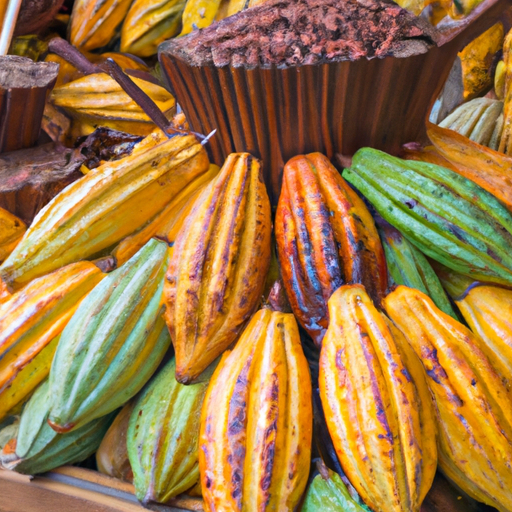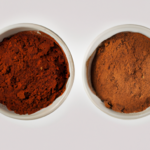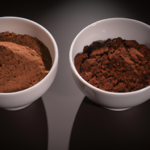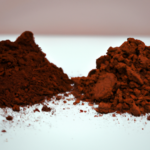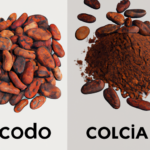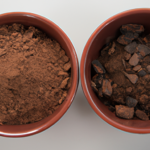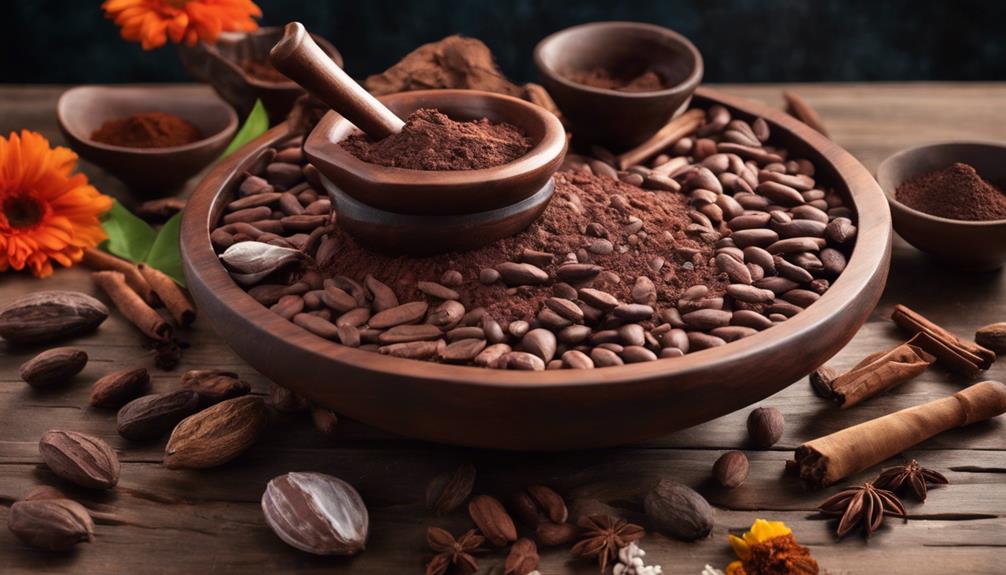Exploring the realms of cacao and cocoa, I am fascinated by the slight distinctions that set these two ingredients apart. This has led me to ponder: what sets raw cacao and cocoa powder apart from each other?
In this article, I aim to unravel the complexities and shed light on this intriguing topic.
Originating from the cacao tree, these two products undergo different processing methods, resulting in distinct flavor profiles and nutritional content. While cacao retains its raw, unprocessed form, cocoa powder undergoes a more intensive process involving roasting and grinding. Understanding these differences is crucial for culinary enthusiasts and health-conscious individuals alike.
Join me as we explore the origins, processing methods, nutritional content, and culinary uses of cacao and cocoa powder. We will also delve into availability, cost, sustainability, and storage considerations. By the end of this article, you will have a comprehensive understanding of these two ingredients and be equipped to make informed choices in your culinary endeavors.
So, let’s embark on this fascinating journey together.
Key Takeaways
- Raw cacao and cocoa powder are derived from the same source, but they undergo different processing methods.
- Raw cacao is made by cold-pressing unroasted cacao beans, while cocoa powder is produced by roasting the beans at high temperatures.
- Raw cacao retains more nutrients and antioxidants compared to cocoa powder due to minimal processing.
- When choosing between raw cacao and cocoa powder, factors to consider include flavor preferences, nutritional benefits, and support for sustainable and fair trade practices.
The Origins of Cacao and Cocoa
The rich history of cacao and cocoa will transport me to exotic lands and ignite my curiosity about their origins.
Cacao, the raw form of chocolate, comes from the cacao tree, which has been cultivated for thousands of years in Central and South America. The Mayans and Aztecs revered cacao for its cultural significance and used it in religious ceremonies.
Cocoa, on the other hand, is the processed form of cacao. To make cocoa powder, cacao beans are fermented, roasted, and ground into a fine powder. This processing technique removes the natural fats, known as cocoa butter, from the cacao beans. The difference between raw cacao and cocoa powder lies in their processing methods.
Now, let’s explore the various processing methods used to transform cacao into cocoa powder.
Processing Methods
When it comes to processing techniques, you’ll be surprised to discover the unique ways in which cacao and cocoa are transformed into delicious treats. The following list will give you an insight into the intricate process:
-
Fermentation: After the cacao beans are harvested, they undergo a fermentation process. This step is crucial as it develops the flavor profiles and reduces bitterness.
-
Roasting: The fermented beans are then roasted to enhance their aroma and deepen the flavors. Roasting also helps to remove moisture and further develop the chocolatey taste.
-
Grinding and Pressing: The roasted beans are ground into a paste, known as chocolate liquor. This paste is then pressed to separate the cocoa solids from the cocoa butter.
These processing methods not only bring out the distinct flavors but also impact the nutritional properties of cacao and cocoa.
Transitioning into the subsequent section about ‘nutritional content,’ let’s explore how these processing techniques affect the final products.
Nutritional Content
The discussion on the Nutritional Content of raw cacao and cocoa powder explores the health benefits of raw cacao and the nutritional differences between cacao and cocoa powder.
Raw cacao is rich in antioxidants, flavonoids, and minerals, which contribute to its potential health benefits such as improved cardiovascular health and mood enhancement.
On the other hand, cocoa powder is processed at a higher temperature, which reduces its nutritional content but still retains some health benefits.
Health benefits of raw cacao
Indulging in raw cacao can boost your health and give you a delectable treat at the same time. This superfood is packed with health benefits due to its minimal processing methods. Here are some reasons why raw cacao is a great addition to your diet:
-
High in antioxidants: Raw cacao contains a wide range of antioxidants that help fight free radicals and reduce inflammation.
-
Mood enhancer: Raw cacao stimulates the production of endorphins and serotonin, improving mood and promoting feelings of happiness.
-
Cardiovascular support: The flavonoids in raw cacao have been shown to lower blood pressure, improve circulation, and reduce the risk of heart disease.
-
Brain booster: Raw cacao is rich in flavonoids and other compounds that enhance cognitive function and improve memory.
-
Culinary versatility: Raw cacao can be used in various culinary creations, such as smoothies, desserts, and baked goods.
Understanding the health benefits of raw cacao sets the stage for exploring the nutritional differences between cacao and cocoa powder.
Nutritional differences between cacao and cocoa powder
One cannot help but be intrigued by the nutritional disparities found within the realm of cacao and cocoa powder.
When comparing the two, one notable difference is the theobromine content. Cacao powder contains a higher concentration of theobromine, a stimulant that can have positive effects on cardiovascular health, while cocoa powder has a lower theobromine content.
Another difference lies in their antioxidant levels. Cacao powder has a higher antioxidant content, which can help protect the body against oxidative stress and inflammation. Cocoa powder, on the other hand, undergoes processing that may decrease its antioxidant levels.
These disparities in theobromine content and antioxidant levels contribute to the distinct nutritional profiles of cacao and cocoa powder.
Moving on to the subsequent section about ‘flavor profiles’, it’s important to consider how these nutritional differences may impact the taste experience.
Flavor Profiles
When it comes to flavor, cacao powder has a distinct earthy and slightly bitter taste, while cocoa powder offers a smoother and milder flavor. Flavor preferences play a crucial role in determining which powder to use in recipes. Some people enjoy the intense and complex flavor of cacao, while others prefer the more subtle taste of cocoa. Understanding these flavor profiles is essential for recipe substitution, as the two powders have different impacts on the overall taste of a dish. To help you make an informed decision, I have created a table comparing the flavor profiles of cacao and cocoa powder:
| Cacao Powder | Cocoa Powder |
|---|---|
| Earthy | Smooth |
| Slightly Bitter | Milder |
| Intense | Subtle |
| Complex | Delicate |
| Rich | Sweet |
Considering these flavor differences, it is important to choose the right powder based on your desired taste outcome. In the next section, we will explore the culinary uses of cacao and cocoa powder, highlighting their versatility in various dishes.
Culinary Uses
Expand your culinary creativity by exploring the various ways you can incorporate these delectable powders into your dishes.
- For culinary applications:
- Use raw cacao powder as a natural sweetener in smoothies or baked goods. Its intense flavor adds depth to chocolate desserts.
- Cocoa powder is ideal for making hot cocoa, chocolate sauces, or dusting over desserts for a rich, velvety finish.
Recipe ideas:
- Experiment with raw cacao powder in homemade energy bars or truffles for a healthy, indulgent treat.
- Add cocoa powder to chili or mole sauces for a subtle hint of chocolate that enhances savory dishes.
These versatile powders offer a wide range of culinary possibilities, allowing you to elevate the taste and presentation of your creations.
Now, let’s explore their availability and cost.
Availability and Cost
When it comes to the availability of raw cacao and cocoa powder, there are some important factors to consider.
Raw cacao is typically more widely available in health food stores and specialty shops, while cocoa powder can be found in most grocery stores.
As for the price comparison, raw cacao tends to be more expensive than cocoa powder due to its higher quality and processing methods. However, the cost can vary depending on the brand and the specific type of cacao or cocoa powder being purchased.
Availability of raw cacao and cocoa powder
Raw cacao and cocoa powder are both readily available in grocery stores and online.
When it comes to raw cacao, it is sourced from the Theobroma cacao tree, native to Central and South America. This unprocessed form of cacao retains its natural nutrients and antioxidants, making it a popular choice among health-conscious individuals.
On the other hand, cocoa powder is a processed form of cacao that has been roasted and ground into a fine powder. Despite the processing, cocoa powder still contains some health benefits, although it may have a slightly lower antioxidant content compared to raw cacao.
In terms of availability, both raw cacao and cocoa powder can be easily found in various brands and forms, including organic options.
Transitioning into the subsequent section about price comparison, it is important to consider the cost differences between these two products.
Price comparison between the two
In terms of price, there is a notable difference between raw cacao and cocoa powder. Raw cacao tends to be more expensive than cocoa powder due to the differences in their processing methods.
Raw cacao is made by cold-pressing unroasted cacao beans, which helps to retain more of the natural nutrients and antioxidants present in the cacao bean. On the other hand, cocoa powder is made by extracting the fat (cocoa butter) from roasted cacao beans, which results in a more processed product. This processing difference contributes to the higher price of raw cacao.
However, it is important to note that both raw cacao and cocoa powder offer health benefits, such as being rich in antioxidants and potentially improving mood and cognitive function.
Transitioning into the subsequent section about sustainability and fair trade, it is also worth considering the ethical and environmental aspects of cacao production.
Sustainability and Fair Trade
Sustainability and fair trade are essential for the production of both cacao and cocoa powder. Cacao farmers employ techniques to minimize environmental impact and promote biodiversity. This includes using organic farming methods and implementing agroforestry systems to preserve natural habitats.
Fair trade certifications guarantee that farmers receive fair wages and work in safe conditions. By supporting fair trade, consumers contribute to the social and economic development of cacao-producing communities.
Moving on to the next section about storage and shelf life, it is important to consider how sustainability and fair trade practices also influence the packaging and transportation of cacao and cocoa powder. These practices ensure that these products reach consumers while minimizing their environmental footprint.
Storage and Shelf Life
Proper storage of raw cacao and cocoa powder is crucial to maintaining their quality and flavor. Raw cacao should be stored in an airtight container in a cool, dry place away from direct sunlight. Exposure to heat and light can degrade its nutritional value and flavor.
Cocoa powder, on the other hand, has a longer shelf life due to its lower moisture content. However, it should still be stored in a cool, dark place to prevent it from absorbing any odors or moisture.
Proper storage of raw cacao and cocoa powder
To keep raw cacao and cocoa powder fresh and delicious, it’s important to know the proper storage methods. Here are three key factors to consider:
-
Temperature: Store raw cacao and cocoa powder in a cool, dry place, away from direct sunlight. Fluctuations in temperature can cause moisture buildup and spoilage.
-
Airtight Containers: Use airtight containers to maintain flavor and prevent moisture absorption. This protects them from exposure to air, humidity, and odors.
-
Avoid Contamination: Keep raw cacao and cocoa powder away from strong-smelling foods or spices as they can easily absorb odors. Also, use clean utensils when scooping out the desired amount.
By following these proper storage techniques, you can extend the shelf life of both raw cacao and cocoa powder. Now let’s explore the differences in their shelf life.
Shelf life differences between the two
To ensure that your cacao and cocoa stay fresh, let’s now dive into how their shelf life varies. Proper storage methods and preservation techniques are crucial in maintaining the quality of these products. The shelf life of raw cacao is generally longer compared to cocoa powder. This is because raw cacao undergoes minimal processing and retains more natural antioxidants, which act as preservatives. On the other hand, cocoa powder is processed at higher temperatures, which reduces its antioxidant content and shelf life. To illustrate the differences, refer to the table below:
| Raw Cacao | Cocoa Powder | |
|---|---|---|
| Shelf Life | 1-2 years | 1 year |
| Storage | Cool, dry place | Cool, dry place |
Understanding these shelf life differences can help you make informed decisions about the storage and usage of your cacao and cocoa. In the subsequent section, we will discuss our conclusions and provide recommendations for optimal storage practices.
Conclusion and Recommendations
In conclusion, when it comes to choosing between raw cacao and cocoa powder, there are several factors to consider. The difference in flavor and nutritional benefits is significant, making it a decision worth considering for any chocolate lover. Raw cacao tends to be more expensive than cocoa powder due to the additional processing steps involved. However, the sustainability practices associated with raw cacao production can justify the higher cost. Raw cacao is often sourced from sustainable farms that prioritize fair trade and organic practices, ensuring the protection of biodiversity and the well-being of farmers. Additionally, raw cacao retains more of its natural antioxidants, minerals, and flavonoids compared to cocoa powder, making it a healthier choice. Therefore, if you are willing to invest in a higher quality and more sustainable chocolate experience, raw cacao is the way to go.
Frequently Asked Questions
Can raw cacao or cocoa powder be used interchangeably in recipes?
In baking, raw cacao and cocoa powder can generally be used interchangeably. However, there are nutritional differences. Raw cacao is less processed and retains more nutrients, while cocoa powder undergoes more processing and may have added ingredients.
Are there any potential health risks associated with consuming raw cacao or cocoa powder?
There may be potential health risks associated with consuming raw cacao or cocoa powder, but they can also provide potential health benefits due to their nutritional differences.
How does the caffeine content compare between raw cacao and cocoa powder?
Compared to cocoa powder, raw cacao generally contains more caffeine. However, the exact caffeine content can vary depending on the brand and processing methods. Taste preference between the two may differ due to the different levels of bitterness.
Are there any specific recipes or dishes where raw cacao or cocoa powder is recommended over the other?
Specific recipes and recommended uses for raw cacao or cocoa powder include smoothies, desserts, and hot beverages. Raw cacao is ideal for raw desserts, while cocoa powder is commonly used in baking recipes.
What are some common misconceptions or myths about raw cacao and cocoa powder?
Oh, the misconceptions people have about raw cacao and cocoa powder! Some believe that raw cacao is a nutritional powerhouse, while cocoa powder is just a processed, inferior version. But let me enlighten you with the truth.
What are the Benefits of Using Raw Cacao Powder Over Cocoa Powder?
When it comes to choosing between raw cacao powder and cocoa powder, the best raw cacao powder is the clear winner. It is packed with antioxidants, minerals, and phytonutrients that are usually lost during the roasting process of cocoa powder. It also has a richer flavor and is less processed, making it a healthier choice.
Conclusion
In conclusion, understanding the difference between raw cacao and cocoa powder is crucial for both culinary and health purposes.
While both are derived from the same source, their processing methods result in distinct nutritional profiles and flavor profiles.
Raw cacao is rich in antioxidants and retains more of its natural nutrients, making it a healthier choice.
On the other hand, cocoa powder is more commonly used in baking and has a milder taste.
For example, in a study comparing the effects of raw cacao and cocoa powder on blood pressure, it was found that raw cacao significantly reduced blood pressure in hypertensive individuals.
Therefore, when choosing between raw cacao and cocoa powder, consider your desired health benefits and culinary preferences.


